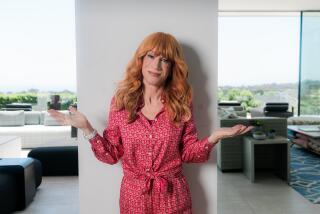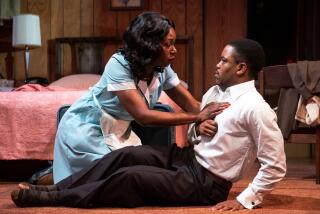Yul Brynner Dies at 65; 30 Years in ‘King and I’
- Share via
Yul Brynner, who with shaved head and regally haughty presence played and replayed the starring role in “The King and I” for more than 30 years, died early today in a New York Hospital. He was 65.
With him when he died at 1 a.m. at the New York Hospital-Cornell Medical Center were his wife, Kathy Lee, and his four children, said Josh Ellis, the actor’s spokesman.
“He died of multiple complications that came as a result of what was originally cancer,” Ellis said. “He faced death with a dignity and strength that astounded his doctors. He fought like a lion.”
“He was a remarkable person,” Charlton Heston, who starred with Brynner in Cecil B. DeMille’s 1956 movie epic “The Ten Commandments,” told the Associated Press. “His work in ‘King and I’ was beyond compare. He was a very special talent. I’m very sorry to hear of his death.”
Though there were other Broadway and movie roles for Brynner, it is doubtful that any successful actor of his time had been so associated with a single character as was Brynner with the arrogant, bombastic King of Siam.
None of Brynner’s other parts were nearly as memorable as the king. If he became typecast, it was something Brynner didn’t seem to mind. For one thing, there were certain physical limitations that kept him from a wider variety of parts.
“I would have liked to play Henry Higgins (in ‘My Fair Lady’),” he told a Times interviewer a decade ago, “but I couldn’t because of my accent and looks. Unless I did it with an Outer Mongolian touring company.”
For another, the money from the play, the movie, and the seemingly countless touring companies of the play made him a millionaire.
Born Taidje Khan on July 11, 1917, on the island of Sakhalin off northern Japan, Brynner was the son of a Mongolian mining engineer and a Gypsy mother who died at his birth. His father was born in Switzerland and later secured Swiss citizenship and changed the family name to Brynner.
For the first eight years of his life, young Yul lived in China, and then was sent by his father to live with his maternal grandmother in Paris, but she died soon afterward. He attended a Paris school for a time, but dropped out at the age of 13 and joined a Gypsy troupe as a traveling minstrel.
He worked as an acrobat in a French circus for three years, performing on the high trapeze. But after a bad injury, Brynner turned from the circus to the stage.
It was acting that brought Brynner to America, touring in a struggling Shakespearean troupe on college campuses. He added English and some Russian (learned from other actors) to his collection of languages that included French, Japanese and Hungarian while playing small parts and driving the troupe’s bus--all for $25 a week.
In February, 1946, he made his debut on Broadway, playing an Oriental prince opposite Mary Martin in “Lute Song.” After 142 performances, Brynner took the show on tour.
But Brynner had doubts about his ultimate success as an actor. Years later, he remembered one night on stage--long before “The King and I”--when an outraged theatergoer hit him with a shoe. “And it was a perfectly serviceable shoe,” he said. “The man must have really hated me.”
Brynner returned to New York in 1948, putting aside his stage acting ambitions and settling comfortably into the role of actor, director and producer in the fledgling television industry, ultimately directing episodes of “Studio One,” one of the more successful live, anthology television shows of the 1950s.
But Brynner fell in love with the script of “The King and I” when Richard Rodgers and Oscar Hammerstein offered him the role. Hammerstein had seen Brynner in “Lute Song,” thought well of him and was influenced by Martin’s recommendation.
The musical story of the imperious Thai king and the proper British teacher, Anna Leonowens, who went to Siam in the 1860s to instruct the king’s huge flock of offspring and then had to acclimate herself to his court habits of polygamy and bowing at ground-level, had a rocky start when it opened out of town in New Haven, Conn., in February, 1951.
“It was a disaster,” Brynner said in 1981. “It was almost five hours long. There was nothing but conflict between Anna and the King. . . . Rogers and Hammerstein understood immediately that unless there was an underlying fascination (between the two characters), then there really couldn’t be a fascinating show.”
With the book cut and sweetened, as well as a couple of new songs added (“Shall We Dance” and “Getting to Know You”) the show, starring Gertrude Lawrence and Brynner, opened in New York at the St. James Theater on March 29, 1951. It was a first-night hit.
“Richard Rodgers told me, ‘You opened. You have a hit. Now freeze it,’ ” he said in late 1984, just before opening in yet another Broadway revival of the show.
“That would’ve killed me. I told him I would be faithful to the inner sense of the piece, but what I did outwardly was my business. I told him, ‘If you cannot agree on that, please replace me.’ And I stayed four years and we became great friends.”
One thing that Brynner did “freeze” was his hair style. He had shaved his head to further resemble a Siamese monarch and kept it shaved for the remainder of his life.
“The King and I” remained on Broadway initially for 1,246 performances before moving on to Chicago, Los Angeles and London on its first go-around. Overall, by the time Brynner reopened the play on Broadway in 1984, he had performed the role 4,400 times, winning a Tony award in 1952 and an Oscar for the 1956 movie version.
Though Brynner tried to avoid being typecast--some of his favorite movie roles included lead parts in “Anastasia” (1956), “The Brothers Karamazov” (1958), “The Magnificent Seven” (1960), and “Westworld” (1973)--he became famous in a superficial sort of way for his shaved head. “Brynner’s Romantic Image Lifts Baldies,” read one newspaper headline.
Despite that, Brynner always returned to “The King and I”--for the money, for the pleasure of a role he loved and, oftentimes, for lack of other work to do. “Until I find a better role, I’ll keep doing this one,” he said in 1980.
Every time Brynner played the king, he said, he would gradually immerse himself in the role each night.
“I couldn’t even explain what it is,” he said. “It’s something that happens while I’m making myself up and I’m alone. When you’ve played eight performances a week for as long as I have, some juices start running.
“I like to sit on stage left, where the stage manager sits, during the overture. I get the audience’s pulse from their reaction to the music, from their sound. It doesn’t even consciously enter my mind. . . .”
His last round of performances in the play, starting in December, 1984, was billed as a farewell engagement--and friends and fans feared that it would be just that.
Brynner, a five-pack-a-day smoker, had learned in 1983 that he had lung cancer. He took radiation treatment and, in Brynner’s words, “the results were spectacular.” Later, Brynner journeyed to Hanover, West Germany, where he was treated by a controversial cancer specialist who advocated carrot-based vitamin treatments to prevent recurrence of the disease.
By the time he opened on Broadway just before Christmas, 1984, Brynner could say the disease was in remission. Indeed, in his later years, he appeared amazingly robust, routinely booming his magnificent voice out to an audience of thousands without the need of body microphones. He danced around the stage with a still-lithe body--he was 6 feet tall and weighed nearly 180 pounds, no more than when he had opened in the role more than 30 years earlier.
Towards the end, because of the cancer, the prospect of eventual death had helped him decide to retire the role, as he told the New York Times in late 1984:
“Having been ill opened my eyes suddenly to the fact that--the Gypsies have a wonderful phrase for it--’Your future is getting shorter.’ There are things I want to do beyond sharpening and honing this role further. . . . I’m not even sure what. At the same time, the illness has changed the king for me. Some lines come as a surprise suddenly--’Everyday, my Lord in heaven show the way’ and ‘Everyday I try to live for one more day.’ This describes completely how I do the show and how I survived the illness.
“Growing up in the Far East helped me. There was an idea that you go to bed not knowing if you have a tomorrow and you must be thankful for every tomorrow and make the most of it. . . . I couldn’t see myself going to bed and waiting to see what would happen with my illness. I preferred to play to 2,000 or 3,000 people and standing ovations. The choice is quite simple.”
Brynner’s last performance as the king was last June 29 at the Broadway Theater in New York City.
More to Read
Only good movies
Get the Indie Focus newsletter, Mark Olsen's weekly guide to the world of cinema.
You may occasionally receive promotional content from the Los Angeles Times.










